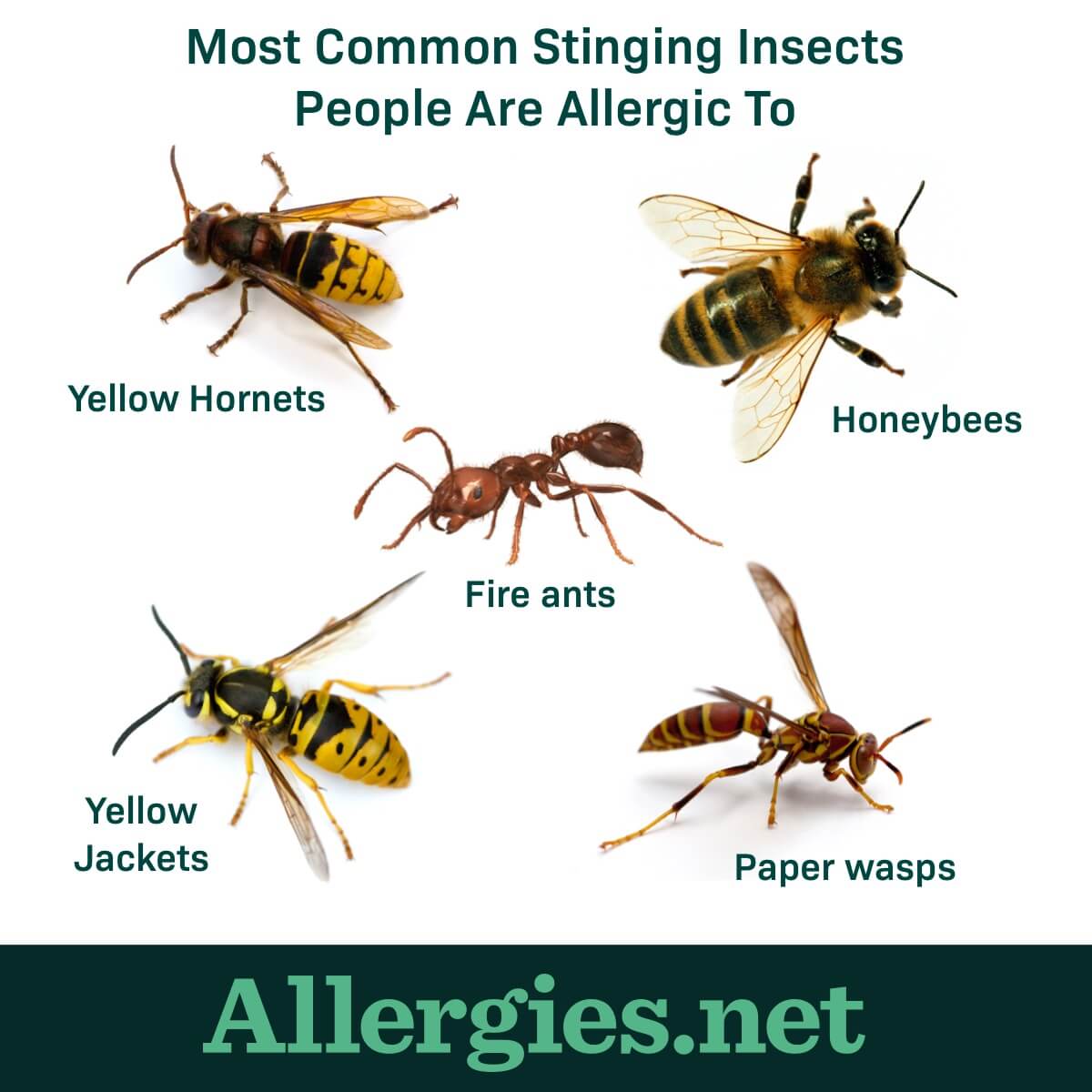Insect Sting Allergies
Reviewed by: HU Medical Review Board | Last updated: April 2022
Most people have at least a mild reaction to being stung by a bee or wasp. This includes redness, pain, and swelling where you were stung. Mild reactions tend to go away in a few hours.1
However, some people have a more serious allergy to the venom of stinging insects. These people may have more redness and swelling that lasts for days. A few have the most serious reaction, anaphylaxis. Anaphylaxis is a life-threatening reaction. In fact, insect stings are a leading cause of death due to anaphylaxis.1,2
Types of insects
The Hymenoptera (hi-men-op-turah) family of insects causes the most allergic reactions to stings. This family includes:1
- Honeybees and bumblebees
- Paper wasps
- Yellow jackets
- Yellow hornets, white-faced hornets
- Fire ants
Who has insect sting allergies?
About 3 of every 100 people in the United States have an insect sting allergy. Venom allergies may develop at any age. However, adults tend to have more severe reactions and more deaths resulting from those severe reactions.1
Men are more often affected than women. Doctors believe this is probably because men are more likely to have jobs that keep them outdoors. Beekeepers are at highest risk of developing this allergy.1
Types of reactions and symptoms
There are 3 types of insect sting reactions: uncomplicated local, large local, and systemic.
Uncomplicated local reactions
An uncomplicated local reaction is the most common type. An area 1 to 2 inches in size will become red, swell, and be painful. It usually develops within minutes of the sting and lasts for a few hours.1
Fire ants may also cause a small, itchy, pus-filled bump called a pustule. Sometimes, swelling and itchiness will last for 1 to 2 days.1
Large local reactions
Large local reactions happen to 1 in 10 people with insect sting allergies. The spot will be larger (about 4 inches), more red, and more swollen than in a mild reaction. The sting site gradually gets bigger over 1 to 2 days and slowly goes away over 5 to 10 days.1
Systemic reactions
A systemic reaction means the whole body reacts, often within minutes. Sometimes, the reaction is hives. Other times, it is anaphylaxis, which is a dangerous reaction. Symptoms of anaphylaxis involve more than 1 organ system, such as the skin, lungs, heart, and gut. Examples include:3,4
- Mouth – Itching, swelling of the lips and tongue
- Throat – Itching, swelling in throat, throat closing, hoarseness
- Skin – Itching, hives, redness, swelling, flushing
- Gut – Vomiting, diarrhea, cramping
- Lungs – Shortness of breath, wheezing, coughing
- Heart – Weak and rapid pulse, dizziness, fainting, pale or blue skin
- Other – Feeling something bad is about to happen, confusion
Anaphylaxis and insect stings
About 40 people die each year from anaphylaxis caused by insect stings. There is some evidence that deaths due to insect stings are underreported. Studies show that half of the people who die from an insect sting did not know they had a venom allergy.1
People who have a history of large local reactions or anaphylaxis are at high risk of reacting this way if bitten in the future. However, more research is needed to fully understand this link.1
Treatments
Treatment depends on how severe the allergic reaction is to the sting. Mild allergic reactions may be treated with a cold compress.1
Large local reactions may be treated with:1
- Cold compresses
- If stung on an arm or leg, elevate the limb
- Steroids (prednisone) for significant swelling
- Antihistamines and steroid creams for itchy skin
If a large local reaction becomes infected, antibiotics may be needed.1
Anaphylaxis must be treated with epinephrine. This is commonly called an Epi-Pen, after the brand name. This drug is given through an auto-injector, usually into the thigh muscle.1
Other types of insect allergies
People also have allergic reactions to other types of insects. Biting insects usually cause minor pain, redness, and itching around the bite. These bites rarely lead to a severe reaction. Biting insects include:2
- Mosquitoes
- Kissing bugs
- Bedbugs
- Fleas
- Certain flies
Dust mites and cockroaches are common insects that may cause allergy symptoms like sneezing, coughing, or runny nose. People sensitive to these insects react to the insect waste instead of a sting or bite.2
